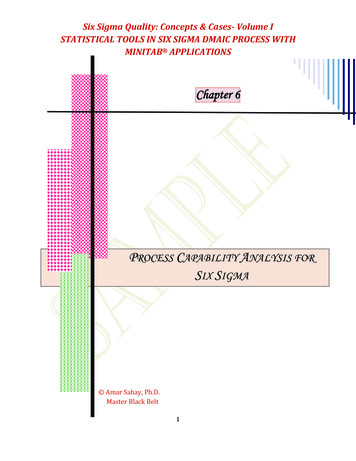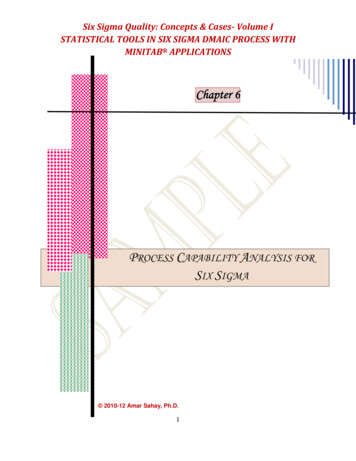
Transcription
Six Sigma Quality: Concepts & Cases‐ Volume ISTATISTICAL TOOLS IN SIX SIGMA DMAIC PROCESS WITHMINITAB APPLICATIONSChapter 6PROCESS CAPABILITY ANALYSIS FORSIX SIGMA Amar Sahay, Ph.D.Master Black Belt1
Chapter 6: Process Capability Analysis for Six SigmaCHAPTER HIGHLIGHTSThis chapter deals with the concepts and applications of process capability analysis inSix Sigma. Process Capability Analysis is an important part of an overall qualityimprovement program. Here we discuss the following topics relating to processcapability and Six Sigma:1.Process capability concepts and fundamentals2.Connection between the process capability and Six Sigma3.Specification limits and process capability indices4.Short‐term and long‐term variability in the process and how they relate toprocess capability5.Calculating the short‐term or long‐term process capability6.7.Using the process capability analysis to: assess the process variability establish specification limits (or, setting up realistic tolerances) determine how well the process will hold the tolerances (the differencebetween specifications) determine the process variability relative to the specifications reduce or eliminate the variability to a great extentUse the process capability to answer the following questions: 8.Is the process meeting customer specifications?How will the process perform in the future?Are improvements needed in the process?Have we sustained these improvements, or has the process regressed toits previous unimproved state?Calculating process capability reports for normal and non‐normal data usingMINITAB.CHAPTER OUTLINEProcess CapabilityProcess Capability AnalysisDetermining Process CapabilityImportant Terms and Their DefinitionsShort‐term and Long‐term VariationsProcess Capability Using HistogramsProcess Capability Using Probability Plot2
Chapter 6: Process Capability Analysis for Six SigmaEstimating Percentage Nonconforming for Non‐normal Data: Example 1Estimating Nonconformance Rate for Non‐normal Data : Example 2Capability Indexes for Normally Distributed Process DataDetermining Process Capability Using Normal DistributionFormulas for the Process Capability Using Normal DistributionRelationship between Cp and CpkThe Percent of the Specification Band used by the ProcessOverall Process Capability Indexes (or Performance Indexes)Calculating Process CapabilityCase 1: Process Capability Analysis (Using Normal Distribution)Case 2: Process Capability of Pipe Diameter (Production Run 2)Case 3:Process Capability of Pipe Diameter (Production Run 3)Case 4: Process Capability Analysis of Pizza DeliveryCase 5: Process Capability Analysis: Data in One Column (Subgroup size 1)(a) Data Generated in a Sequence, (b) Data Generated RandomlyCase 6: Performing Process Capability Analysis: When the ProcessMeasurements do not follow a Normal DistributionProcess Capability using Box Cox TransformationProcess Capability of Non‐normal Data Using Box‐Cox TransformationProcess Capability of Nonnormal Data Using Johnson’s TransformationProcess Capability Using Distribution FitProcess Capability Using Control ChartsProcess Capability Using x‐bar and R ChartProcess Capability SixPackProcess Capability Analysis of Multiple Variables Using Normal DistributionProcess Capability Analysis Using Attribute ChartsProcess Capability Using a p‐ChartProcess Capability Using a u‐ChartNotes on ImplementationHands‐on ExercisesThis document contains explanation and examples on process capability analysis fromChapter 6 of our Six Sigma Volume 1. The book contains numerous cases, examples andstep‐wise computer instruction with data files.3
Chapter 6: Process Capability Analysis for Six Sigma4PROCESS CAPABILITYProcess Capability is the ability of the process to meet specifications. Thecapability analysis determines how the product specifications compare with theinherent variability in a process. The inherent variability of the process is the part ofprocess variation due to common causes. The other type of process variability is dueto the special causes of variation.It is a common practice to take the six‐sigma spread of a process’s inherentvariation as a measure of process capability when the process is stable. Thus, theprocess spread is the process capability, which is equal to six sigma.PROCESS CAPABILITY ANALYSIS: AN IMPORTANT PART OF AN OVERALLQUALITY IMPROVEMENT PROGRAMThe purpose of the process capability analysis involves assessing and quantifyingvariability before and after the product is released for production, analyzing thevariability relative to product specifications, and improving the product design andmanufacturing process to reduce the variability. Variation reduction is the key toproduct improvement and product consistency.The process capability analysis is useful in determining how well the process willhold the tolerances (the difference between specifications). The analysis can also beuseful in selecting or modifying the process during product design and development,selecting the process requirements for machines and equipment, and above all,reducing the variability in production processes.DETERMINING PROCESS CAPABILITYThe following points should be noted before conducting a process capabilityanalysis. Process capability should be assessed once the process has attained statisticalcontrol. This means that the special causes of variation have been identified andeliminated. Once the process is stable, . In calculating process capability, the specification limits are required in mostcases, Unrealistic or inaccurate specification limits may not provide correctprocess capability.4
Chapter 6: Process Capability Analysis for Six Sigma 5Process capability analysis using a histogram or a control chart is based on theassumption that the process characteristics follow a normal distribution. Whilethe assumption of normality holds in many situations, there are cases where theprocesses do not follow a normal distribution. Extreme care should be exercisedwhere normality does not hold .:SHORT‐TERM AND LONG‐TERM VARIATIONThe standard deviation that describes the process variation is an integral part ofprocess capability analysis. In general, the standard deviation is not known and mustbe estimated from the process data. The estimated standard deviation used in processcapability calculations may address "short‐term" or "long‐term" variability. Thevariability due to common causes is described as "short‐term" variability, while thevariability due to special causes is considered "long‐term" variability.:Some examples of "long‐term" variability may be lot‐to‐lot variation,operator‐to‐operator variation, day‐to‐day variation or shift‐to‐shift variation. Short‐term variability may be within‐part variation, part‐to‐part variation, variations within amachine, etc. However, the literature differs on what is "long‐term" and what is"short‐term" variation.In process capability analysis, both "short‐term" and "long‐term" indexesare calculated and are not considered separately in assessing process capability. Theindexes Cp and Cpk are "short‐term" capability indexes and are calculated using"short‐term" standard deviation whereas, Pp and Ppk are "long‐term" capability andare calculated using "long‐term" standard deviation estimate. These are discussed inmore detail later.DETERMINING PROCESS CAPABILITYFollowing are some of the methods used to determine the process capability.The first two are very common and are described below.(1) Histograms and probability plots,(2) Control charts, and(3) Design of experiments.PROCESS CAPABILITY USING HISTOGRAMS: SPECIFICATION LIMITS KNOWN:5
Chapter 6: Process Capability Analysis for Six Sigma6Suppose that the specification limits on the length is 6.00 0.05. We now want todetermine the percentage of the parts outside of the specification limits. Since themeasurements are very close to normal, we can use the normal distribution tocalculate the nonconforming percentage. Figure 6.2 shows the histogram of the lengthdata with the target value and specifications limits. To do this plot, follow theinstructions in Table 6.2.Table 6.2HISTOGRAM WITHOpen the worksheet PCA1.MTWSPECIFICATION LIMITS From the main menu, select Graph & HistogramClick on With Fit then click OKFor Graph variables, .Click the Scale then click theReference Lines tabIn the Show reference lines at data values type 5.95 6.0 6.05Click OK in all dialog boxes.Histogram of e 6.2: Histogram of the Length Data with Specification Limits and TargetHistogram of ure 6.3: Fitted Normal Curve with Reference Line for the Length Data6
Chapter 6: Process Capability Analysis for Six Sigma7Table 6.4Cumulative Distribution FunctionNormal with mean 5.999 and standard deviation 0.0199xP( X x )5.95 0.00690226.05 0.994809From the above table, the percent conforming can be calculated as 0.994809 ‐0.0069022 0.98790 or, 98.79%. Therefore, the percent outside of the specificationlimits is 1‐0.98790 or, 0.0121 (1.21%).PROCESS CAPABILITY USING PROBABILITY PLOTSA probability plot can be used in place of a histogram to determine the process capability.Recall that a probability plot can be used to determine the distribution and shape of the data. Ifthe probability plot indicates that the distribution is normal, the mean and standard deviationcan be estimated from the plot. For the length data discussed above, we know that thedistribution is normal. We will construct a probability plot (or perform a Normality test) .Table 6.5NORMALITY TESTOpen the worksheet PCA1.MTWUSING PROBABILITY PLOT From the main menu, select Stat & Basic Statistics&Normality TestFor Variable, Select C1 LengthUnder Percentile Line, .type 5 0 84 in the boxUnder Test for Normality, .Anderson DarlingClick OK::For a normal distribution, the mean equals median, which is 50th percentile, andthe standard deviation is the difference between the 84th and 50th percentile. FromFigure 6.4, the estimated mean is 5.9985 or 5.999 and the estimated standarddeviation is 84th percentile ‐ 50th percentile 6.0183 ‐ 5.9985 0.0198Note that the estimated standard deviation is very close to what we got fromearlier analysis. The process capability can now be determined as explained in theprevious example.7
Chapter 6: Process Capability Analysis for Six Sigma8Probability Plot of re 6.4: Probability Plot for the Length DataContinued ESTIMATING PERCENTAGE NONCONFORMING FOR NON‐NORMAL DATA:EXAMPLE 1When the data are not normal, an appropriate distribution should be fitted tothe data before calculating the nonconformance rate.Data file PCA1.MTW shows the life of a certain type of light bulb. Thehistogram of the data is shown in Figure 6.5. To construct this histogram, followthe steps in Table 6. 1.Histogram of Life in 00Life in Hrs18002400Figure 6.5: Life of the Light bulb8494.1484.9150
Chapter 6: Process Capability Analysis for Six Sigma9For the data in Figure 6.5, it is required to calculate the capability with a lowerlimit because the company making the bulbs wants to know the minimum survivalrate. They want to determine the percentage of the bulbs surviving 150 hours or less.The plot in Figure 6.5 clearly indicates that the data are not normal. Therefore, ifwe use the normal distribution to calculate the nonconformance rate, it will lead to awrong conclusion. It seems reasonable to assume that the life data might follow anexponential distribution. We will fit an exponential distribution to the data .Table 6.6FITTING DISTRIBUTION(EXPONENTIAL)Open the worksheet PCA1.MTWFrom the main menu, select Graph & HistogramClick on With Fit then click OK:Click the Distribution tab, check the box next to Fit DistributionClick the downward arrow and select ExponentialClick OK in all dialog boxes.The histogram with a fitted exponential curve shown in Figure 6.6 will bedisplayed. The exponential distribution seems to provide a good fit to the data. Theparameter of the exponential distribution (mean 494.1 hrs) is .Histogram of Life in HrsExponential150Mean 494.1N15060Frequency50403020100040080012001600Life in Hrs20002400Figure 6.6: Exponential Distribution Fitted to the Life DataThe plot using the exponential distribution clearly fits the data as most of theplotted plots are along the straight line. To do the probability plots in Figure 6.7,follow the instructions in Table 6.7 Table 6.79
10Chapter 6: Process Capability Analysis for Six SigmaOpen the worksheet PCA1.MTWFrom the main menu, select Graph & Probability PlotsClick on Single then click OKFor Graph variables, type C2 or select Life in HrsClick on Distribution then select Normal .Click OK in alldialog boxes.PROBABILITY PLOTProbability Plot of Life in HrsProbability Plot of Life in e 0.00510Mean494.1N150AD0.201P-Value 0.9549080706050403020105321510.10.1-100001000Life in Hrs200030001(a)10100Life in Hrs100010000(b)Figure 6.7: Probability Plots of the Life DataTable 6.9Cumulative Distribution FunctionExponential with mean 494.1x P( X x )150 0.261831The table shows the calculated probability, P (x 150) 0.2618. This meansthat 26.18% of the products will fail within 150 hours or less.CAPABILITY INDICES FOR NORMALLY DISTRIBUTED PROCESS DATA10
Chapter 6: Process Capability Analysis for Six SigmaProcess C apability (C p 1.0)Process Capability (C p 1)L SL11USLL SLUSLProcess C apability (C p 1.0)L SLUSLMINITAB provides several options for determining the process capability. The optionscan be selected by using the command sequence Stat &Quality Tools &CapabilityAnalysis. This provides several options for performing process capability analysisincluding the following: NormalBetween/WithinNon‐normalMultiple Variables (Normal)Multiple Variables (Nonnormal)BinomialPoissonDETERMINING PROCESS CAPABILITIES USING NORMAL DISTRIBUTIONThe capability indexes in this case are calculated based on the assumption thatthe process data are normally distributed, and the process is stable and within control.Two sets of capability indexes are calculated: Potential (within) Capability and OverallCapability.Potential Capability The potential or within capability indexes are: Cp, Cpl, Cpu, Cpk, and Ccpk11
12Chapter 6: Process Capability Analysis for Six Sigma These capability indexes are calculated based on the estimate of within or thevariation within each subgroup. If the data are in one column and the subgroupsize is 1, this standard deviation is calculated based on the moving range (theadjacent observations are treated as subgroups). If the subgroup size is greaterthan 1, the within standard deviation is calculated using the range or standarddeviation control chart (you can specify the method you want). . the potential capability of the process tells what the process would becapable of producing if the process did not have shifts and drifts; or, how theprocess could perform relative to the specification limits .(Overall Capability The overall capability indexes are: Pp, Ppl, Ppu, Ppk, and CpmThese capability indexes are calculated based on the estimate of overall or the overall variation, which is the variation of the entire datain the study. According to the MINITAB help screen, the overall capability of theprocess tells how the process is actually performing relative to thespecification limits.If there is a substantial difference between within and overall variation, it maybe an indication that the process is out of control, or that the other sources ofvariation are not estimated by within capability [see MINITAB manual].Note: According to some authors, Cp and Cpk assess the potential “short‐term”capability using a “short‐term” estimate of standard deviation, while Pp and Ppkassess overall or “long‐term” capability using the “long‐term” or overall standarddeviation. Table 6.17 contains the formulas and their descriptions.FORMULAS FOR THE PROCESS CAPABILITY USING NORMAL DISTRIBUTIONTable 6.17 shows the formulas for different process capability indexes.12
Chapter 6: Process Capability Analysis for Six Sigma13Table 6.17Capability Indexes for Potential (within) Process CapabilityUSL upper specification limitCp U SL LSL6 w ith inCPL LSL lower specification limit within estimate of within subgroup standard deviationx LSL 3 withinRatio of the difference between process mean and lowerspecification limit to one‐sided process spreadx process meanC PU USL x 3 withinC PK Min. C PU , C PL Ratio of the difference between upper specification limitto one‐sided process spreadTakes into account the shift in the process. The measureof CPK relative to CP is a measure of how off‐center theprocess is. If C P C P K the process is centered; ifC P K C P the process is off‐center. CCPK USL 3 within::: CCPK Min{(USL ),( LSL)} 3 within::Note: In all the above cases, the standard deviation is the estimate of within subgroupstandard deviation. As noted above, the formulas for estimating standard deviationdiffers from case to case. It is very important to calculate the correct standarddeviation. The standard deviation formulas are discussed later.Relationship between Cp and Cpk13
Chapter 6: Process Capability Analysis for Six Sigma14The index Cp determines only the spread of the process. It does not take intoaccount the shift in the process. Cpk determines both the spread and the shift in theprocess.:and the relationship between Cp and Cpk is given byCpk (1 k ) CpNote that Cpk never exceeds Cp. When Cpk Cp, the process is centered midwaybetween the specification limits. Both these indexes Cp and Cpk together provideinformation about how the process is performing with respect to the specificationlimits.OVERALL PROCESS CAPABILITY INDICES (OR PERFORMANCE INDICES)MINITAB also calculates the overall process capability indexes. These indexes arePp, PPL, PPU, Ppk, and Cpm. The formulas for calculating these indexes are similar tothose of potential capabilities except that the estimate of the standard deviation is anoverall standard deviation and not within group standard deviation. The formulas forthe overall capability indexes refer to Table 6.18.Table 6.18Capability Indices for Overall Process CapabilityCp USL LSL 6 withinUSL upper specification limitLSL lower specification limit overall estimate of overall subgroup standarddeviationThis is the performance index that does not take intoaccount the process centering.Continued PPL PP U x LSL 3 overallU SL x 3 o v e r a llRatio of the difference between process mean and lowerspecification limit to one‐sided process spreadx process mean::14
Chapter 6: Process Capability Analysis for Six Sigma:PP K M in . PP L , PP U This index is the ratio of (USL‐LSL) to the square rootof mean squared deviation from the target. This indexis not calculated if the target value is not specified. Ahigher value of this index is an indication of a betterprocess. This index is calculated for the known valuesof USL, LSL, and the target (T).C pmUSL LSLC pm n( tolerance ) *C pm 15 (xi 1i T )2n 1 (xto le r a n c e*2i 1iT target value (USL LSL)/2 mtolerance 6 (sigma tolerance)M in .{ ( T L S L ), (U S L T )}nUsed when USL, LSL, and target value, T areknown T)2USL, LSL, and target, T are known butT (USL LSL)/2n 1::(Note: The above formulas are very similar to what MINITAB uses to calculate theseindexes. See the MINITAB help screen for details).In this section, we present several cases involving process capability analysiswhen the underlying process data are normally distributed. The process capabilityreport and the analyses are presented for different cases.Examples on Process CapabilityExample 6.3Calculate the capability indices ‐ Cp, Cpl, Cpu, and Cpk for the process for which the dataare given below. Interpret their meaning. Explain the difference between Cp and Cpk. USL 10.050, LSL 9.950, 9.999 and 0.0165 as estimates of and ( is the same as x) .Solution:Cp USL LSL 6 10.050 9.950 1.016(0.0165)(Note; is the estimate of standard deviation).CPL x LSL 3 9.999 159.950 0.993(0.0165)
Chapter 6: Process Capability Analysis for Six SigmaCPU USL x 3 1610.050 9.999 1.033(0.0165)CPK Min. CPU , CPL Min{0.99,1.03} 0.99Cp 1.01 means that the process is marginally capable (just able to meet thespecifications). Cp Cpk means that the process is centered. This process is slightly off‐centered.Difference between Cp and Cpk: The process capability ratio or Cp does not take intoaccount the shift in the process mean. It does not consider where the mean is relative tothe specifications. Cp measures only the spread of the specifications relative to the 6‐sigma spread or the process spread. Cpk on the other hand, .Example 6.4(a) Given x 70 and 2 (as estimates of and ), LSL 58, USL 82. Calculatethe process capability indices: Cp, Cpl, Cpu, and Cpk.Solution: The problem is visually shown in Figure 6.20.Cp LSLUSL LSL 6 82 58 2.06(2)USL7058 6476 82Figure 6.20: LSL and USL for Example 6.4CPL x LSL 3 70 58 2.03(2)CPU USL x 3 CPK Min. CPU , CPL Min{2.0, 2.0} 2.016 82 70 2.03(2)
Chapter 6: Process Capability Analysis for Six Sigma(b)17Calculate the capability indices for the data in part (a) if the mean has shiftedfrom 70 to 73 (all the other values are same as in part (a)).::Example 6.5Complete Table 6.18 by calculating the Cp, Cpk, and the process fallout, or the defects inparts per million (PPM) for different sigma levels. Calculate ratios Cp, Cpk, and the processfall out when the process is centered and when there is a shift of 1.5‐sigma. Note: Cpk iscalculated based on an assumed shift of 1.5s. Some calculations for 3s process are shownin the table. Complete the rest of the table.Table 6.18: Calculation of Defects (PPM) for Different Sigma LevelSigma LevelProcess Centered?CpC pk 3 Yes1.01.0Process Fallout(Defects in PPM)2700 PPM1.00.566,811 PPM 4 NoYes 4.5 NoYes 6 NoYesNoSolution: Calculations for 3sCurve A in Figure 6.22 shows a 3s process. Curve B shows a shift of 1.5s in the mean. TheCp, Cpk, and the process fallout (in defective PPM) can be calculated as shown below.3s Centered ProcessCp USL LSL 6 6 1.06 To calculate the process fallout or the defective, calculate P(Z 3.0) using the standardnormal curve. This can be calculated using MINITAB (see instructions in Table 6.19).17
Chapter 6: Process Capability Analysis for Six Sigma18M ean11.5BAUSLLSL Figure 6.22: A 3‐Sigma Process with a Shift of 1.5‐SigmaTable 6.19In MINITAB, execute the following commandsCalc &Probability Distributions & NormalComplete the Normal Distribution dialog box click the circle to the left ofCumulative probability and type the following in the boxes:Mean0.0Standard deviation1.0Input constant3.0Click OK.The session screen will show the result below.Cumulative Distribution FunctionNormal with mean 0 and standard deviation 1x3P( X x )0.998650Using the above result, P ( z 3) 1 0.998650 0.00135and,P ( z 3) 0.00135Therefore, defective in a million (PPM) for a 3s process (2*0.00135)*106 2700. Thisprocess fallout is for a centered process. It indicates that this process would produce 2700defective products out of a million.Cp, Cpk, and the process fallout (in defective PPM) for a shift of 1.5s18
Chapter 6: Process Capability Analysis for Six Sigma19Curve B shows a shift of 1.5s in the mean. The Cp, Cpk, and the process fallout (indefective PPM) can be calculated as:Cp CPUUSL LSLUSL .3 6 ; 6 1.06 LSL . 0.5CPL 3 CPK Min. CPU , CPL Min{0.5, 0.5} 0.5To calculate the process fallout or the defective, calculate P(Z 3.0) using the standardnormal curve with a mean of 1.5. This can be calculated using MINITAB. Follow theinstructions in Table 6.19 but type 1.5 for the mean. The result is shown below.Cumulative Distribution FunctionNormal with mean 1.5 and standard deviation 1x P( X x )30.933193Using the above result, P ( z 3) 1 0.933193 0.0668072The total process fallout or defective (in PPM) for a shift of 1.5 would be 0.066811*106(6.68072 0.0003)% or, 66,811 in a million. This value is usually reported as 66,807 in theliterature. Table 6.20 shows the Cp, Cpk, and the defective (in PPM) for 4s, 4.5s and 6sprocesses.Calculations for a 4s Process with a Shift of 1.5sFigure 6.23 shows a 4‐Sigma process with a shift of 1.5‐sigma on either side. The Cp, Cpk,and the process fallout (in defective PPM) for this process are calculated below.19
Chapter 6: Process Capability Analysis for Six SigmaUSLLSL 20 Target Figure 6.23: A 4‐Sigma Process with a Shift of 1.5‐SigmaWhen the process is centered:Cp USL LSL 6 8 1.336 To calculate the process fallout or the defective, calculate P(Z 4.0) using the standardnormal curve. The instructions are the same as in Table 6.19 except the following — .Cumulative Distribution FunctionNormal with mean 0 and standard deviation 1x4P( X x )0.999968From the above table, P ( z 4) 1 0.999968 0.000032:::Cp, Cpk, and the process fallout (in defective PPM) for a shift of 1.5sFigure 6.23 shows a shift of 1.5 in the mean for a 4‐sigma process. The Cp, Cpk, and theprocess fallout (in defective PPM) can be calculated as:CPU USL 4 1.5 0.833 3 20
Chapter 6: Process Capability Analysis for Six Sigma21CPK Min. CPU , CPL Min{., 0.83} 0.83To calculate the process fallout or the defective, calculate P(Z 4.0) using the standardnormal curve with a mean of 1.5. This can be calculated using MINITAB. Follow theinstructions in Table 6.19 but type a 1.5 for the mean and 4.0 in the mean box. The resultis shown below.Cumulative Distribution FunctionNormal with mean 1.5 and standard deviation 1x P( X x )40.993790From the above table,P ( z 4) 1 0.993790 0.00621Therefore, the process fallout or defective (in PPM) for a shift of 1.5 would be0.00621*106 or, 6210. Similarly, the defective (in PPM) for a shift of ‐1.5 would also be6210.Table 6.20 shows the Cp, Cpk, and the defective (in PPM) for 3 , 4 , 4.5 , and 6 processes. Note that the defects in PPM corresponding to the Cpk values are calculated foronly 1.5s shift in the positive direction. For 1.5s shift, the process fall out values will betwice the values shown in Table 6.20. You should verify these results.Table 6.20: Cp, Cpk, and Process Fallout in PPM for Different Sigma LevelsSigma Level 3 4 4.5 6 Process Centered?YesNoYesNoYesNoYesNoCpC pk1.01.01.331.00.5:1.5::1.52.021Process Fallout(Defects in PPM)270066,807:::::3.4
Chapter 6: Process Capability Analysis for Six Sigma22Example 6.1‐ Calculating Process Capability using Control ChartsA chemical company manufactures and markets 50 lb. nitrogen fertilizer for the lawns. Dueto some recent problems in their production process, overfilling and under filling in thefilling bags of fertilizer have been reported. The problem was investigated and appropriateadjustments were made to the machines that are used to fill the fertilizer bags. When theprocess was believed to be stable, the quality supervisor collected 30 samples each of size 5.The control charts for x and R were constructed and the tests were conducted for thespecial or assignable causes. The process was found to be within control and no assignablecauses were present. The x and R control charts for the process are shown in Figure 6.15.Determine the process capability for this process based on the average of range value, or Rreported on the R chart. Note that R ‐ the average of all subgroup range can be used toestimate the process standard deviation.Xbar-R C hartUC L 5 1 .0 6 1Sample Mean51.050.5X 49.93150.049.549.0LC L 4 8 . 8 0 214710131619222528Sample RangeS am p leUC L 4 . 1 4 143R 1.958210LC L 014710131619222528S am p leFigure 6.15: The x and R Control Charts for Example 6.1Solution:First, estimate the standard deviation, from the given information using: Note: R . 0.842d2is the estimate of . The value of R is reported in the chart for range in Figure6.15 and d 2 is obtained from the table ‐ ‘factors for computing 3 control limits’ in AppendixB (Table B.3). The value of d 2 .The process capability, 6 6(0.842) 5.05222
Chapter 6: Process Capability Analysis for Six Sigma(a)23 The process capability can also be determined by estimating the using the averageof standard deviations, s of the subgroups instead of average of the subgroup range.Here we demonstrate the calculation of process capability using the standarddeviation.Figure 6.16 shows the x S ‐ control charts for the average and standard deviation.Determine the process capability using the value of s in the control chart.First, estimate the standard deviation, from the given information using: Note: s . 0.841c4is the estimate of . The value of s is reported in the chart for standarddeviation (s) . and c4 is obtained from the table ‐ ‘factors for computing X b ar-S C h artU C L 5 1 .0 6 1Sample Mean5 1. 05 0. 5X 4 9 .9 3 15 0. 04 9. 54 9. 0L C L 4 8 .8 0 214710131619222528S am p leU C L 1 .6 5 3Sample StDev1. 61. 2S 0 .7 9 10. 80. 4LC L 00. 0147101316192225S am p leFigure 6.16: The x and S‐ control charts The process capability:6 5.046Continued 2328
Chapter 6: Process Capability Analysis for Six Sigma24CASE 1 : PROCESS CAPABILITY ANALYSIS (USING NORMAL DISTRIBUTION)In t
Six Sigma. Process Capability Analysis is an important part of an overall quality improvement program. Here we discuss the following topics relating to process capability and Six Sigma: 1. Process capability concepts and fundamentals 2. Connection between the process capability and Six Sigma










